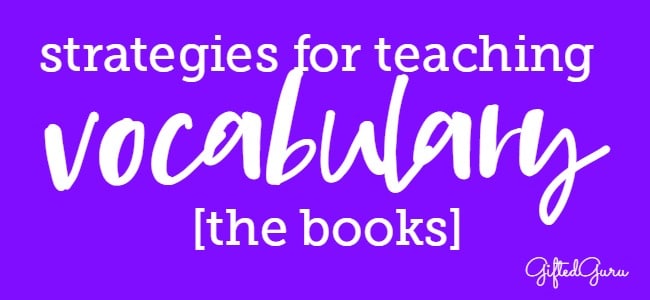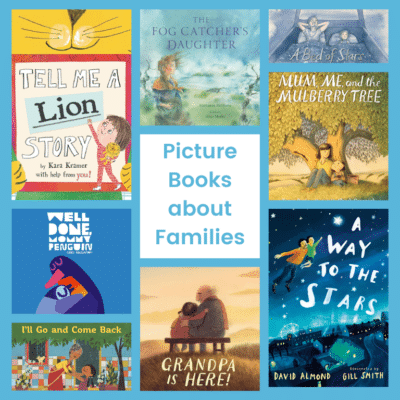Strategies for Teaching Vocabulary
Strategies for teaching vocabulary are a critical part of every teacher’s toolkit, yet searching for them is a little bit of an Alice in Wonderland experience – down the rabbit hole you go.
Responding to a question I got in an email (shout out to blog post muse Allison Rothwell from Douglas County School District in Colorado), I started to write a post about strategies for teaching vocabulary, along with resources.
It quickly grew in manner of those sponge things you add water to, and so I’ve divided it up.
This post is Part 1 of a four-part series on teaching vocabulary. If you would like to check out the rest of the series, visit the posts below
- Teaching Vocabulary: The books (this one)
- Theories & Techniques that work (and don’t)
- 21 Activities for Teaching Vocabulary
- Ideas for English Language Learners
The Books
These books are not listed in any particular order, and they cover a wide range of applications. Some are true curriculum. Some are theory. Some are practice. Several are a combo platter. Browse and add to your Goodreads “want to read” list.
There are different levels of this book for different grade level bands (6 – 9 and 3 – 5). It’s based on the building blocks of words (prefixes, suffixes, root words), and has loads of lists! The 6 – 9 book has 54 lists of words based on the same group of building blocks, each divided into lessons that include practice opportunities. There is a nice list of vocabulary activities in the front of the book that you could use with any of the lists, as well as other words. I like these books, yet students would still need more authentic practice with the words.
Word Wise
Published by Mindware, this two-book series is subject driven. There are is a volume for content knowledge, such as history, biology, etc., and also one for cultural ideas, such as politics and family and hobbies. The books have the words defined, and quizzes for testing those words. While I like the variety of the words, I don’t find the books compelling alone. They’re a good place to find words, and teachers would then have to create their own more authentic interactions with the words. They are a good place to go to find words to differentiate vocabulary instruction for gifted learners.
Teaching Basic and Advanced Vocabulary: A Framework for Direct Instruction
This is Marzano’s book of the theory and practice of teaching vocabulary (see his six step process in “Techniques that Work” in a coming post). It’s what it claims to be – a book about the ideas for direct instruction of vocabulary. I’m not particularly recommending it, but it is worthwhile if you want to implement his process with fidelity. Note: “advanced” vocabulary here is academic vocab, not advanced grade levels. It skews elementary. If you want to get a copy, poke around on Amazon to find a used copy from some third-party seller.
Vocabulary Games for the Classroom
This is the companion volume to Marzano’s other book above, Teaching Basic and Advanced Vocabulary: A Framework for Direct Instruction. It’s got the actual classroom activities more spelled out.
Word Power: What Every Educator Needs to Know about Teaching Vocabulary
More of a pamphlet than a book, this little volume is one you can pick up used for $5 or so. It’s worth it for the lists of common suffixes and prefixes (complete with percentages) alone, but it’s got some great activity strategies as well.
Ancient Roots and Ruins: A Guide to Understanding the Romans, Their World, and Their Language
This is a solid contextual base for vocabulary study of Latin. It’s got differentiated lesson plans for gifted learners, and is more of an entire cultural study unit than vocabulary in isolation. I would use this in a GT pull-out situation, or as a really good option for students who have mastered the on-level vocabulary. It would also work to cannibalize it for individual lessons and activities. This is not a vocabulary book per se, in that it’s far broader, yet this would truly improve students’ understanding of English through the exploration of Latin. I would teach this.
Instant Word Power
Possibly the ugliest, most user-unfriendly vocabulary book available, with the possible exception of its companion volume, Word Power Made Easy, this book nonetheless deserves a place in this list because of its sheer effectiveness. It’s a study of roots, suffixes, and prefixes in both Greek and Latin, and it does a great job. I taught this for my 9th and 10th grade vocabulary in high school classes for years, and as awful as it looks, I’ve not found anything I like better. You have to create your own fun to go with it (see upcoming ideas post).
Quick Activities to Build a Very Voluminous Vocabulary (Grades 4-8)
This is a pretty robust compilation of vocabulary activities that you could use with many different words (it has some vocab included, but you can use the activities with other words as well). None of the activities are unique, but if you’d like to save the time trying to hunt them all down, this is a volume that may be a good resource for you. It says grades 4 – 8, but I’d only use it with gifted kids at the fourth grade level because some of the activities are a little tricksty. Look, you can pick it up for a penny, so the risk is looooooow.
Bringing Words to Life, Second Edition: Robust Vocabulary Instruction
This is far more theory than practice, but if you really want to understand vocabulary from the inside out, this is a must read. Be sure to get the 2nd edition. There aren’t a ton of strategies, but there are other books and ideas for that, including the companion volume by the same authors (see below). It’s worth it for the content if you want to know ahead of time what’s most likely to work so you don’t waste time on techniques that are doomed to fail.
Creating Robust Vocabulary: Frequently Asked Questions and Extended Examples (Solving Problems in Teaching of Literacy)
This is the book you need to go with Bringing Words to Life. It has actual examples and takes the theory into practice in a way that really works. Get both books if you’re wanting to implement excellent vocabulary instruction in a real, live classroom.
The Vocabulary Book: Learning & Instruction (Language and Literacy Series)
This is Michael Graves’ book (from “four techniques you must use” fame in the techniques list coming up next). It’s not a beach read, but like Bringing Words to Life, it belongs in the professional library of people serious about vocabulary study. Again, I’m singing my same “poke around” song because you can pick this one up super cheap as well.
Words, Words, Words: Teaching Vocabulary in Grades 4-12
This book is one I’d get if I were looking for a book on what I was doing wrong. As a teacher myself, I appreciated her narrative about her own evolution of vocabulary instruction. Others might not like that part, but you can skip it if you like. It has examples of activities and student work, which I also like. Her other books are good as well, so take a peek at the recommended titles also.
Teaching Vocabulary Explicitly
Free book! This whole (short) book is a free download from the Pacific Center for Education and Learning. It has brief explanations of many of the ideas found in the larger, longer texts.
Why start with the books?
When you think about strategies for teaching vocabulary, you rarely think, “Oh, I think I’ll read a bunch of books about it.” No, sireee, Bob. You go straight to Pinterest #truth.
It would have been way more fun to start with the ideas, but it’s important to get you off on the right foot so you can repeat success. If you do nothing more than read the free book, that’s awesome. Theory guides practice. If you try to do that in the opposite order, you eventually crash and burn.
Just a reminder, you can check out the entire vocabulary series with the links below:
- Teaching Vocabulary: The books (this one)
- Theories & Techniques that work (and don’t)
- 21 Activities for Teaching Vocabulary
- Ideas for English Language Learners

Note: This content uses referral links. Read my disclosure policy (it’s fascinating) for more info.




